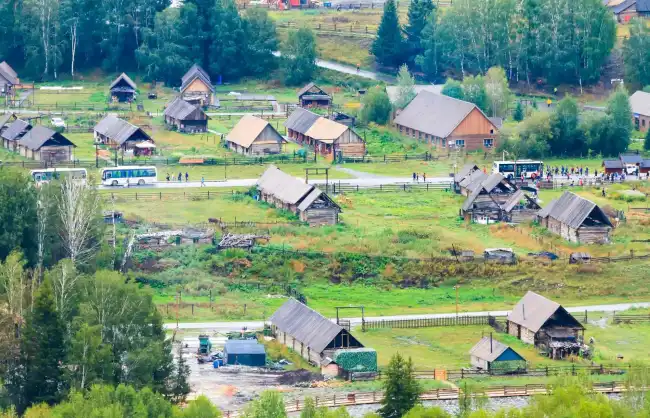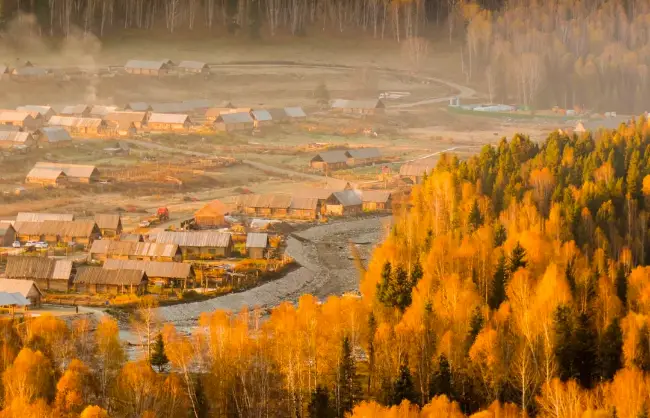Located in the Altay Mountains of northern Xinjiang and within Kanas Nature Reserve, Hemu Village is one of the three remaining habitats of the Tuva people who live a traditional nomadic lifestyle of grazing animals and hunting. Being surrounded by towering mountains and lush birch forests, the village is widely known for its stunning natural beauty which is especially breathtaking in autumn when the surrounding birch forests turn golden. Every year, thousands of nature and photography lovers flock here to marvel at its serene and picturesque view of traditional wooden houses, the misty mountains, and the peaceful countryside.
Fast Facts of Hemu Village
- Location: Kanas Nature Reserve in the Altay region, Xinjiang, China
- Travel essentials: Accommodations and restaurants are available in the nearby town of Jiadengyu.
- Area: Approximately 5 square kilometers.
- Recommended Time to Go: from June to Mid-October.
- Time Needed: 1-2 days exploring the village and the surrounding area.
- Highlights: Traditional wooden houses, breathtaking scenery, horseback riding, and cultural experiences.
- Suited to: Travelers interested in experiencing the traditional way of life in China’s remote and beautiful regions.
What to See and Do in Hemu Village
As a popular scenic and cultural destination in Xinjiang, Hemu Village is no shortage of attractions and charming activities to amaze tourists. Below are some of our suggestions for what to see and do when traveling to Hemu Village.
Discover secrets of Tuva people’s wooden houses:
When arriving at Hemu Village, you will be impressed by the many wooden houses which are homes of local Tuva people. According to the legend, Tuva people are the offspring of soldiers who followed Genghis Khan on the western campaign. They still comunicate with the rare Tuva language and make a living by hunting and herding. Their wooden houses are a reflection of their unique culture and lifestyle. The houses are built with logs and stones, with birch bark covered on the roof to waterproof. As the temperature can drop below -30°C in this area, Tuva people built half of their houses underground to keep warm. They think east is auspicious as it welcomes the rising sun and the blessings of nature, thus set a door facing east for each house.

Explore the surrounding birch forest:
Surrounding Hemu Village are lush mountains and a vast expanse of birch forest that covers the mountain slopes. The birch trees change colors with the shifting seasons, with green leaves in summer and looking like a golden sea in autumn. Taking a leisure walk in the forest, you’ll encounter a natural wonderland with wild flowers, mushrooms, squirrels, deer, and many wild birds. Ranking as one of the most scenic attractions in this area, the birch forest is surely a can’t miss for photographers and nature lovers.
Experience Tuva people’s culture and lifestyle:
As we mentioned above, the Tuva people in Hemu Village are said to be the offspring of warriors who followed Genghis Khan on the western campaign. They still preserve their rare Tuva language and the simple and ancient lifestyle by grazing animals and hunting. While in Hemu Village, you can stay in their traditional wooden houses, visit a Tuva family (locals are very hospitable and welcome guests to visit their family) to learn their religion, rituals and ceremonies, savor their local food, and play their traditional instruments, such as horse-head fiddle and the mouth harp.
Enjoy the breathtaking view of Hemu River and Hemu Bridge:
Originated from the snowmelt of the Youyi Mountain, Hemu River flowes through the Hemu Village, and can be seen as the lifeblood of local Tuva people and the surrounding birch forest. The river changes its color according to the weather and the time of the day, from light green to deep blue. It creates a lively and harmonious scene with various fish and birds inhabiting here.

Crossing the Humu River is an ancient wooden bridge, Hemu Bridge, which will lead you to the viewing platform of Hemu Village. It is the great place to marvel at the panoramic view of the village and the surrounding forest and mountains. Having been standing there for over 100 years, the bridge is seen as a symbol connecting with nature and their ancesters by local Tuva people.
Best Time to Visit Hemu Village
The most recommended time to visit Hemu Village is from June to early October when the scenery is vibrant, the wildlife is popping and the temperature is comfortable. September is when the village at most beautiful as the birch leaves all trun golden or brown, creating a stunning contrast with the blue sky. June to August is when the surrounding grasslands at their greenest and adorned with wild flowers, but prepare for the large crowds and higher prices at this time since the summer holiday brings peak season for this area. May and October are recommended for those who want to escape the peak season and still can enjoy pleasant weather.
You May Like: 12 Breathtaking Places to Visit in China in Autumn
Attractions nearby Hemu Village
There are several nearby attractions worth visiting, including:
Kanas Lake : a natural wonder that boasts breathtaking scenery and diverse wildlife.
Keketuohai National Geopark : home to unique geological formations and diverse wildlife.
How to Get to Hemu Village
By flight and then shuttle bus:
Take a flight from Urumqi Diwopu International Airport to Burqin Kanas Airport at first. The flight will take about an hour and 40 minutes. Then, reach Hemu Village by a 2 hours shuttle bus ride which costs CNY 100.
By long-distance bus:
There are three daily long-distance buses from Urumqi to Burqin County, which will take about 6 hours, and cost about CNY 148-185. Then, you can take another bus from Burqin County to Hemu Village, which takes about three to four hours and costs CNY 50.









